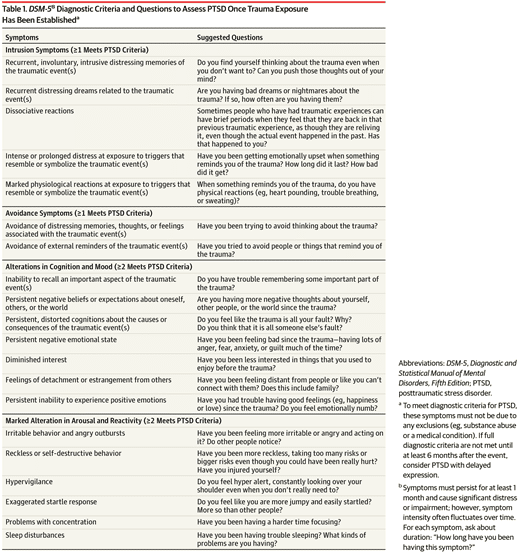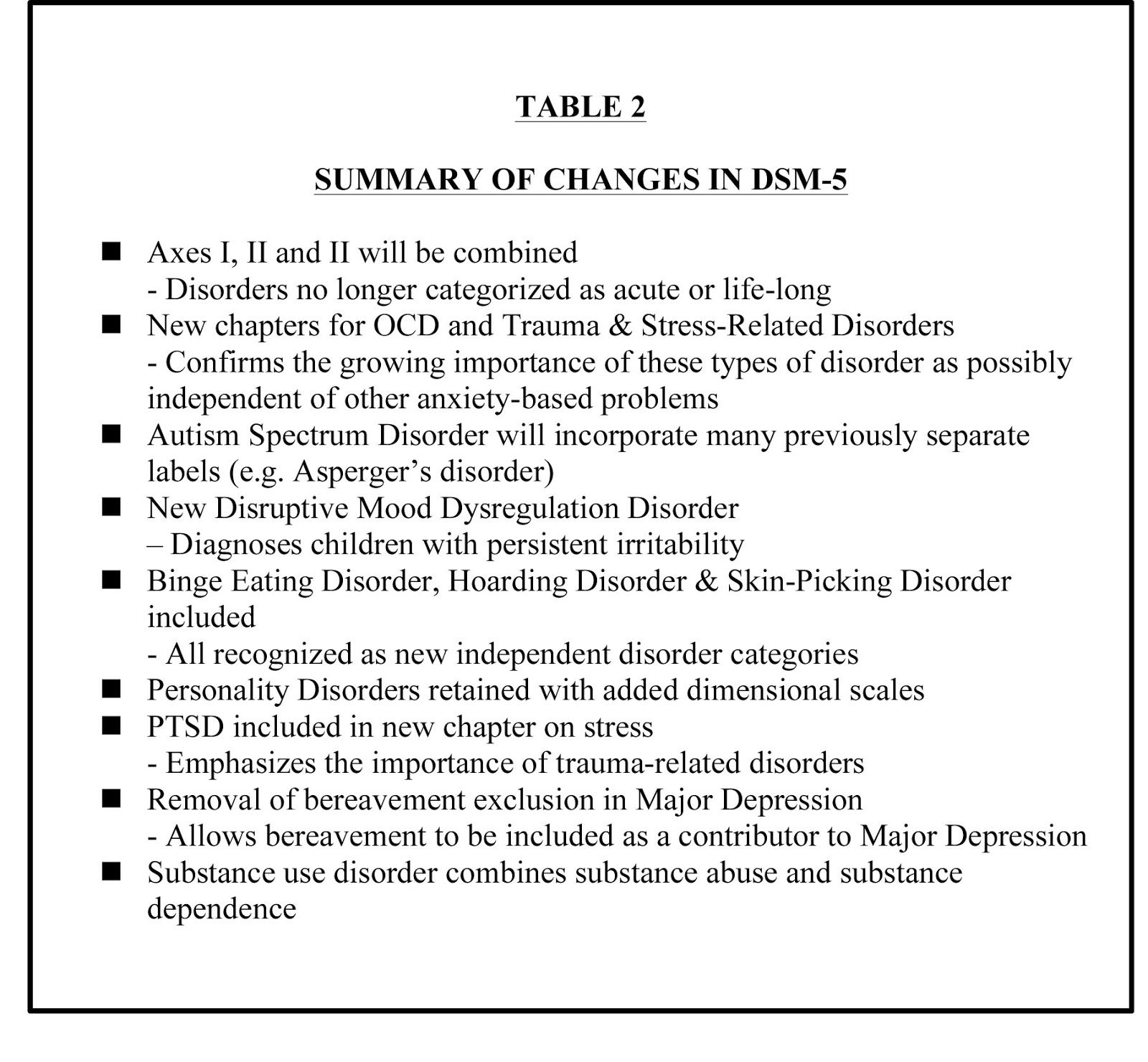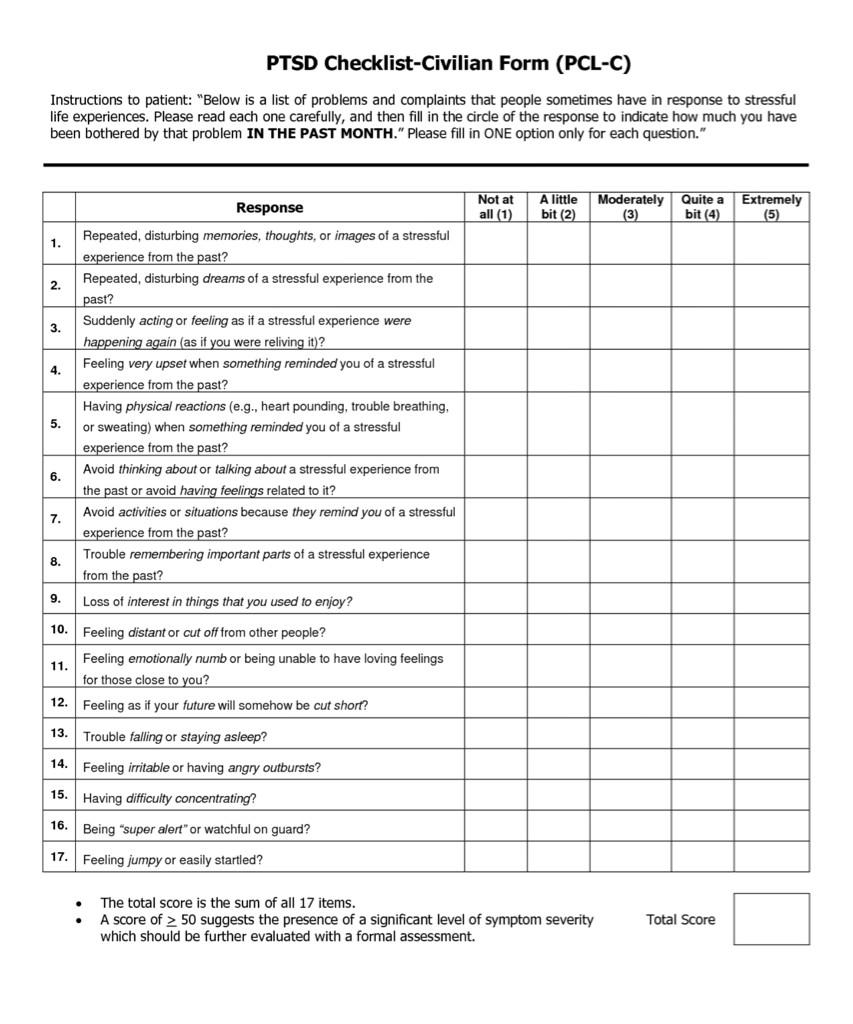Suicide Risk And Comorbidities
Traumatic events increase a persons suicide risk, and PTSD is strongly associated with suicidal ideation and suicidal attempts.
PTSD is also linked to other mental disorders. According to DSM-5, those with PTSD are 80% more likely than those without it to have symptoms that meet the diagnostic criteria for at least one other mental disorder, such as depressive, bipolar, anxiety, or substance abuse disorders. Although females are at greater risk of PTSD, males diagnosed with PTSD are more likely to have a comorbidity. Among Afghanistan and Iraq veterans, its been found that the co-occurrence of PTSD and a mild traumatic brain injury was 48%.
Disinhibited Social Engagement Disorder
In many cases, children go through a distinct phase of stranger anxiety. Its an important developmental milestone to help them learn about intuition and boundaries.
Children living with disinhibited social engagement disorder , on the other hand, may not be afraid of unfamiliar people or strangers. suggests this adaptation stems from severe conditions early on, such as extreme neglect or abuse.
Children living with this diagnosis may:
- appear overly affectionate with acquaintances
- feel comfortable leaving their caregivers
- wander off with unfamiliar people
Ptsd Facts With The Dsm
No, you dont have to read the entire DSM to better understand PTSD or the symptoms youre experiencing. Its a professional resource, so while valuable, it can be dense and clinical. Youll get the best, most accurate diagnosis by talking with medical and mental health professionals. But in the meantime, you can use information from the DSM to begin to explore your mental health.
Recommended Reading: Can You Get Disability With A Gaf Of 50
Gaf Scores No Longer Used
Before August 2014, the VA used the Global Assessment of Functioning Score to rate PTSD and other veterans mental health disabilities. As of August 2014, VA adopted the DSM-5 which does not use GAF scores.
So, PTSD disability claims received by VA or that were pending VA review on or after August 4, 2014, will be evaluated under DSM-5 diagnostic criteria and rated according to CFR 38 § 4.130.
Is Ptsd Acute Or Chronic

Col. Philip Holcombe] So the difference between acute and chronic post-traumatic stress disorder is the timeline of the symptoms. So when the symptoms occur for less than four weeks but longer than two days, we diagnose that as acute PTSD. When the symptoms last for longer than four weeks, we call that chronic PTSD.
Recommended Reading: Social Security Office San Angelo Tx
Big Changes Coming: Dsm
The Diagnostic and Statistical Manual, 5th edition has significantly changed the way psychologists and psychiatrists diagnose Post-Traumatic Stress Disorder . The new DSM-5 criteria for PTSD arise from the DSM-5 completely changing PTSDs category of disorder. It was considered an Anxiety Disorder, but now it is a trauma and stressor-related disorder. Creating this new class of disorders is significant, because it means that the American Psychiatric Association has identified different kinds of disorders that arise from exposure to a traumatic event. All of the disorders in this new class of trauma and stressor-related disorders share a common criteria: exposure to trauma.
What Are The Implications Of The Dsm
Changes in the diagnostic criteria have minimal impact on prevalence. National estimates of PTSD prevalence suggest that DSM-5 rates were only slightly lower than DSM-IV for both lifetime and past-12 month . When cases met criteria for DSM-IV, but not DSM-5, this was primarily due the revision excluding sudden unexpected death of a loved one from Criterion A in the DSM-5. The other reason was a failure to have one avoidance symptom. When cases met criteria for DSM-5, but not DSM-IV, this was primarily due to not meeting DSM-IV avoidance/numbing and/or arousal criteria . Research also suggests that similarly to DSM-IV, prevalence of PTSD for DSM-5 was higher among women than men, and increased with multiple traumatic event exposure .
Don’t Miss: Ptsd And How It Affects The Brain
Criterion D: Negative Alterations In Cognitions And Mood
Many PTSD psychotherapy protocols focus on changing both assimilated beliefs and overgeneralized beliefs that are now characterized by PTSD Criteria D2 and D3. Therefore, an accurate assessment of PTSD Criteria D2 and D3 prior to initiating treatment will provide insight into the specific beliefs that should be targeted throughout the course of treatment. Of course, these symptoms should be regularly assessed during therapy to determine the extent to which they are being modified by the intervention. Finally, because dysfunctional cognitions which remain after treatment may continue to produce high levels of distress , clinicians should assess for the continued existence of these beliefs during follow-up assessments.
The addition of symptom D4, the presence of a persistent negative emotional state , also has important implications for PTSD assessment within the context of treatment. The introduction of D4 is a reflection of the re-categorization of PTSD as a trauma- and stressor-related disorder rather than as an anxiety disorder. This new classification is a reflection of research that has suggested that, although the reaction to a traumatic event may be anxiety- or fear-based, it may also be most prominently expressed through dysphoric, externalizing, or dissociative symptom profiles .
What Is The Dsm
DSM stands for Diagnostic and Statistical Manual of Mental Disorders. Itâs a book that is basically like an encyclopedia of mental health conditions. The book originally was published in 1952, but has been updated multiple times resulting in the current edition of the DSM-5.
The DSM was created by over a hundred and sixty clinicians and researchers from all over the globe. The purpose of creating the DSM is to provide a handbook for mental health professionals and other healthcare workers.
The DSM includes lists of symptoms and criteria that they can use in order to diagnose patients with mental disorders. This guidebook helps to make diagnosis and communication about mental illness more consistent.
Over the years, the book has continued to be updated and revised as there is research consistently happening on an ongoing basis around mental health disorders. These revisions help to keep the book accurate for our current day in order to help the most amounts of people. The most recent additions to the book were made in order to include symptoms that people were commonly experiencing with mental disorders such as PTSD, but weâre not already included in the book.
Because mental health professionals are using this book in order to diagnose patients, a lack of the right symptoms being included could cause people not to be diagnosed. This would mean that they would not have access to the treatment that they would need in order to gain control of their mental health challenges.
You May Like: Is Mortgage Disability Insurance Worth It
Effects To Veterans From Dsm
Studies cited by the VA suggest that the prevalence of PTSD will decline slightly under the DSM-5. The fact that the total number of required symptoms has been reduced, especially in the avoidance cluster, may indicate that prevalence will actually increase. What is certain, however, is that the diagnostic tools the VA uses like Disability Benefits Questionnaires, CAPS, PC-PTSD and PCL tests will require revision to match the changes in the DSM-5. Changes in thinking from upper chain of command usually results in some errors. People need time to adapt. So, veterans should carefully scrutinize their C& P exams in light of the new DSM-5.
Advocates Help Veterans with New PTSD Criteria
Our advocates for veterans will stay on top of the new PTSD criteria and alternative diagnoses available for disabled vets in need of VA disability compensation. Learn more about VA disability benefits for PTSD or contact Veterans Help Group for a free case evaluation. Helping veterans and their families is all we do.
What Is The Definition Of Trauma
Trauma is an emotional or physical response to one or more physically harmful or life threatening events or circumstances with lasting adverse effects on your mental and physical well-being, according to the Substance Abuse and Mental Health Services Administration .
This could be an event youve personally experienced, witnessed happening to someone else, heard about happening to a close loved one, or heard about through your job .
For more information and support tools, you can read Psych Centrals Finding a Path Through Trauma resource.
The symptoms of PTSD fall into four main groups:
- intrusion symptoms
- changes in cognition and mood
- physical reactivity
After a traumatic event, you may experience at least one of these intrusion symptoms:
- intrusive memories about what happened
- distress when youre reminded of the incident
- physical reactions to stress, like increased heart rate and blood pressure
Don’t Miss: Is Attention Deficit Disorder A Developmental Disability
Ptsd In Preschool Children
Infants and children aged six years old or younger can be diagnosed with PTSD, but young children’s thinking and ability to express themselves in words is limited. This means both their symptoms and diagnostic criteria are slightly different from those in adults or older children. Most of the research on Preschool PTSD involved three- to six-year-olds, with some studies also including younger children. Babies and toddlers can have PTSD: the minimum age for diagnosis is one year old.:272-274The criteria for Posttraumatic Stress Disorder for Children 6 Years and Younger are “developmentally sensitive”. Some of the changes from the main PTSD criteria include:
- constricted play is an example of “diminished interest in significant activities”
- social withdrawal or behavioral changes can indicate “feelings of detachment or estrangement.
- extreme temper tantrums are now included with “irritability or outbursts of anger”
- intrusive symptoms such as flashbacks and intrusive thoughts do not always manifest overt distress in preschool childrenScheeringa states that “while distressed reactions are common, parents also commonly reported no affect or what appeared to be excitement”
- fewer avoidance symptoms are included because avoidance is internalized, and harder to detect by observation, for example in pre-verbal children
Developmental Trauma Disorder
Specify If: With Dissociative Symptoms

In addition to meeting criteria for diagnosis, an individual experiences high levels of either of the following in reaction to trauma-related stimuli:
Don’t Miss: Does A Spouse Get Social Security Disability After Death
How Do The Dsm
Overall, the symptoms of PTSD are generally comparable between DSM-5 and DSM-IV. A few key alterations include:
- The revision of Criterion A1 in DSM-5 narrowed qualifying traumatic events such that the unexpected death of family or a close friend due to natural causes is no longer included.
- Criterion A2, requiring that the response to a traumatic event involved intense fear, hopelessness, or horror, was removed from DSM-5. Research suggests that Criterion A2 did not improve diagnostic accuracy .
- The avoidance and numbing cluster in DSM-IV was separated into two criteria in DSM-5: Criterion C and Criterion D . This results in a requirement that a PTSD diagnosis includes at least one avoidance symptom.
- Three new symptoms were added:
- Criterion D : Overly negative thoughts and assumptions about oneself or the world and, negative affect
- Criterion E : Reckless or destructive behavior
Continuing Education
PTSD Overview and Treatment
The course describes the DSM-5 diagnostic criteria for PTSD and evidence-based treatments. Videos of Veterans with PTSD and clinicians are included.
What Is The Main Symptom Cluster Of Ptsd
The diagnosis of PTSD is further characterized by three distinct symptom clusters: re-experiencing of the traumatic event through such phenomena as dreams, flashbacks, and intrusive, distressing thoughts avoidance and numbing, characterized by such phenomena as avoidance of trauma reminders and numbing of …
Also Check: Can An Ex Spouse Get Social Security Disability Benefits
Ptsd Illusions And Hallucinations
hearing voicesParanoia
“Flashbacks in Posttraumatic Stress Disorder must be distinguished from illusions, hallucinations, and other perceptual disturbances that may occur in Schizophrenia, other Psychotic Disorders, Mood Disorder with Psychotic features, a delirium, Substance-Induced Disorders, and Psychotic Disorders Due to a General Medical Condition.” :467
What Helps With Ptsd And Complex Ptsd
There are two particular interventions that are generally recommended if a child or young person has a diagnosis of PTSD : Trauma-focused Cognitive Behavioural Therapy and Eye Movement Desensitisation and Reprocessing . Research has consistently found that these are effective for PTSD in children and young people. However that does not mean that they will work for all children with PTSD and some research indicates that other approaches might also be effective .
There is much less research evidence about what interventions are effective for Complex PTSD, however there is emerging evidence that what works for PTSD is likely to be effective for Complex PTSD , but it may require more sessions and more focus on developing a trusting relationship .
Read Also: When Will 2022 Va Disability Rates Be Released
Changes To The Ptsd Diagnosis And Implications For Assessment In Ptsd Treatment
In 2013, the American Psychiatric Association introduced the fifth edition of the Diagnostic and Statistical Manual for Mental Disorders . In this version, there are some notable changes to the PTSD diagnosis, including that it is no longer included as an anxiety disorder. Instead, it is included in a new category called the trauma- and stressor-related disorders along with acute stress disorder and the adjustment disorders.
In terms of the actual diagnostic criteria, the first notable change concerns the stressor criterion . In DSM-IV, Criterion A was divided into two parts: an objective component and a subjective component . Criterion A1 required that the person experienced, witnessed, or was confronted with an event or events that involved actual or threatened death or serious injury, or a threat to the physical integrity of self or others . Criterion A2 further required that the persons response involved intense fear, helplessness or horror . Criterion A in DSM-5 now requires:
Criterion A2 has been removed completely from DSM-5 because it did not improve the PTSD diagnostic accuracy .
The changes made to the PTSD diagnosis have important implications for PTSD assessment. In the following section, we describe the manner in which some of these changes to the diagnosis have particular implications for PTSD assessment within the context of treatment .
Table 1 Summary of recommendations to clinicians regarding DSM-5 changes and implications for assessment
Criterion F: Duration Of Symptoms
Even if a person fulfills all the required criteria, a diagnosis of PTSD requires persistence of the symptoms for more than one month.
A person may fulfill all criteria immediately following a traumatic event but display fewer or none of the required symptoms two weeks after the event. Although the criteria were present for a time, the person would not meet the duration requirement.
You May Like: Are Social Security Disability Benefits Retroactive
What Are The Criteria Of Ptsd Dsm
PTSD DSM-5 means Post-Traumatic Stress Disorder is diagnosed using the fifth edition of the Diagnostic and Statistical Manual of Mental Disorders.
The main changes from DSM-IV-TR to DSM-V are:
-Reexperiencing symptoms must occur on more than one occasion.
-A wider range of stressors can trigger symptoms .
-Symptoms last for more than a month.
-There are four distinct symptom clusters: intrusion, avoidance, negative changes in cognition and mood, and alterations in arousal and reactivity.
PTSD is a disorder that can develop after someone has experienced or witnessed a traumatic event. These are such as a natural disaster, a serious accident, a terrorist act, war/combat, rape, or other violent personal assault.
PTSD can happen to anyone. It is not just something that affects soldiers or people who have been in car accidents.
PTSD symptoms are generally grouped into four types: intrusive memories, avoidance, negative changes in thinking and mood, and changes in physical and emotional reactions.
People with PTSD may feel stressed or frightened even when they are not in danger.
Criterion C: Avoidance Symptoms

The third criterion for a PTSD diagnosis is avoidance of reminders of the trauma.
This could be an avoidance of thoughts or feelings about the event or avoidance of trauma-related reminders altogether. A person who suffered sexual assault may display avoidance of thoughts and feelings of the assault and do their best to never think about the event.
Someone who witnessed a person drowning may avoid trauma-related reminders and stay away from pools or bodies of water, for example.
In the case of military veterans, they may avoid any depictions of violence to avoid reminders of their own trauma. For a diagnosis of PTSD, the presence of at least one of these symptoms is required.
Read Also: Prodromal Symptoms Schizophrenia
Don’t Miss: Does Traumatic Brain Injury Qualify For Disability
Criterion E: Alterations In Arousal And Reactivity
For a diagnosis of PTSD, at least two of the following symptoms that began or worsened after the stressor must be present:
- Irritability or aggression
- Risky or destructive behavior
- Increased startle reaction
- Difficulty concentrating or sleep disturbances.
These alterations in arousal and reactivity are a defense mechanism for preventing further trauma.
What Does Va Pay In Disability Benefits For Ptsd
As of 2019, a veteran with no dependents with PTSD would receive the following monthly compensation after an award of VA benefits:
- 0% disability rating: $0.00
- 70% disability rating: $1,403.71
- 100 disability rating: $3,057.13
Note that with a 0 percent rating, the VA recognizes your service-connected PTSD is present, yet it is not to the extent that the condition damages your ability to perform gainful employment or interfere with daily activities.
If the condition deteriorates, you should request to increase your PTSD disability rating
Recommended Reading: How To Apply Disability In Canada
Criterion D: Negative Alterations In Cognition And Mood
A person who receives a diagnosis of PTSD must display at least two of the following symptoms following the stressor:
- Inability to recall key features of the stressor
- Overly negative thoughts or assumptions about oneself or the world
- Exaggerated blaming of self or of others for causing the trauma
- Negative affect
- Feelings of isolation
- Difficulty experiencing a positive effect
